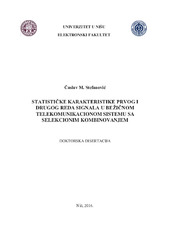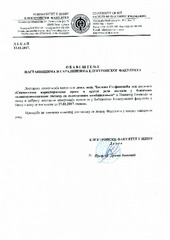| dc.contributor.advisor | Đorđević, Goran T. | |
| dc.contributor.other | Nikolić, Zorica | |
| dc.contributor.other | Perić, Zoran | |
| dc.contributor.other | Panić, Stefan | |
| dc.contributor.other | Petrović, Mile | |
| dc.creator | Stefanović, Časlav M. | |
| dc.date.accessioned | 2017-07-24T08:20:17Z | |
| dc.date.available | 2017-07-24T08:20:17Z | |
| dc.date.available | 2020-07-03T16:02:14Z | |
| dc.date.issued | 2017-05-19 | |
| dc.identifier.uri | http://eteze.ni.ac.rs/application/showtheses?thesesId=5123 | |
| dc.identifier.uri | https://nardus.mpn.gov.rs/handle/123456789/8427 | |
| dc.identifier.uri | https://fedorani.ni.ac.rs/fedora/get/o:1369/bdef:Content/download | |
| dc.identifier.uri | http://vbs.rs/scripts/cobiss?command=DISPLAY&base=70052&RID=533894038 | |
| dc.description.abstract | In doctoral dissertation, first and second order system performances of wireless
communication system in the presence of fading and interference are considered.
Theoretically, four cases are taken into consideration, and obtained numerical results are
graphically presented and analyzed.
Firstly, wireless mobile communication system with the receiver that contains
automatic frequency control (AFC) loop operating over fading channel in the presence of
single interference is considered. Performance measures, such as average switching rate
(ASR) and mean time lose of lock (MTTL), are defined. In this doctoral dissertation, ASR
and MTTL, for three different fading channels: Kg, α-μ and k-μ are obtained.
In the next chapter, wireless relay communication system with two sections in the
presence of multipath fading is considered. Signal envelope at the input of the receiver can
be expressed as product of the first section signal envelope and the second section signal
envelope. For such system model, average level crossing rate (LCR) for the case when
radio relay system of the first section operates over Nakagami-m fading environment and
second section operates over k-μ fading environment is obtained. Wireless relay system
with two sections in the presence of non-linear α-μ fading channel is than taken into
consideration. Moreover, radio relay system with two sections in the presence of multipath
fading and interference is also considered. LCR of the ratio of the product of two k-μ
random processes and k-μ random process is calculated. Finally, LCR of the ratio of
Rician random process and product of two Rician random processes is obtained.
Wireless communication system with two inputs SSC diversity receiver operating
over correlated multipath η-μ fading in the presence of interference is than considered.
Joint probability density function and joint distribution cumulative function of the ratios of
signal to interference at inputs of SSC receivers are calculated. By using obtained
expressions for probability density function (PDF), average bit error probability (ABER)
for different coherent and non-coherent modulation schemes is obtained while by using
derived cumulative distribution function (CDF), outage probability (OP) is obtained.
At the end of doctoral dissertation, macrodiversity system with macrodiversity
SSC receiver and two microdiversity SC receivers operating over Gamma shadowed
multipath fading channel is proposed. In one case Nakagami-m multipath fading channel is
considered while in the second case k-μ multipath fading is considered. System
performances of the proposed system are derived and numerical results are graphically
presented and discussed | en |
| dc.format | application/pdf | |
| dc.language | sr | |
| dc.publisher | Универзитет у Нишу, Електронски факултет | sr |
| dc.rights | openAccess | en |
| dc.rights.uri | https://creativecommons.org/licenses/by/4.0/ | |
| dc.source | Универзитет у Нишу | sr |
| dc.subject | bežične telekomunikacije | sr |
| dc.subject | automatic frequency control loop | en |
| dc.subject | diverziti tehnike | sr |
| dc.subject | efekat senke | sr |
| dc.subject | feding | sr |
| dc.subject | interferencija | sr |
| dc.subject | kolo za automatsku kontrolu učestanosti | sr |
| dc.subject | makrodiverziti sistem | sr |
| dc.subject | selekciono
kombinovanje | sr |
| dc.subject | srednji broj osnih preseka | sr |
| dc.subject | statističke karakteristike prvog i drugog reda | sr |
| dc.subject | verovatnoća otkaza | sr |
| dc.subject | diversity systems | en |
| dc.subject | fading | en |
| dc.subject | first and
second order statistical characteristics | en |
| dc.subject | level crossing rate | en |
| dc.subject | interference | en |
| dc.subject | shadowing | en |
| dc.subject | outage
probability | en |
| dc.subject | wireless telecommunications | en |
| dc.title | Statističke karakteristike prvog i drugog reda signala u bežičnom telekomunikacionom sistemu sa selekcionim kombinovanjem | sr |
| dc.type | doctoralThesis | en |
| dc.rights.license | BY | |
| dcterms.abstract | Ђорђевић, Горан Т.; Николић, Зорица; Перић, Зоран; Панић, Стефан; Петровић, Миле; Стефановић, Часлав М.; Статистичке карактеристике првог и другог реда сигнала у бежичном телекомуникационом систему са селекционим комбиновањем; Статистичке карактеристике првог и другог реда сигнала у бежичном телекомуникационом систему са селекционим комбиновањем; | |
| dc.identifier.fulltext | https://nardus.mpn.gov.rs/bitstream/id/52192/Disertacija.pdf | |
| dc.identifier.fulltext | http://nardus.mpn.gov.rs/bitstream/id/52193/Stefanovic_Caslav.pdf | |
| dc.identifier.fulltext | https://nardus.mpn.gov.rs/bitstream/id/52193/Stefanovic_Caslav.pdf | |
| dc.identifier.fulltext | http://nardus.mpn.gov.rs/bitstream/id/52192/Disertacija.pdf | |
| dc.identifier.rcub | https://hdl.handle.net/21.15107/rcub_nardus_8427 | |



